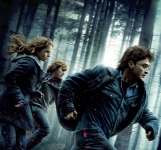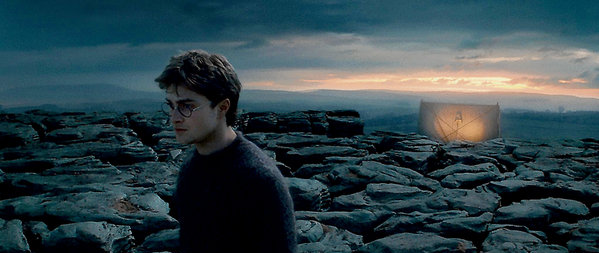“Shot Through the Heart” is a weekly segment in which I rant about a story that means the world to me. Each week we’ll go over a film, book, short story, or game that touched me in ways that are hard to put into words without them just turning into word vomit. This week we’re talking about my favorite Harry Potter film – Harry Potter and the Deathly Hallows Pt. 1!
Harry Potter is important to a lot of people. For many, it introduced them to reading, to literature. Others found their way to fantasy, never having experienced it before. Still, others just fell in love with the characters, deciding to be part of their world.
 It wasn’t like this for me. I wasn’t into Harry Potter until later, when I was a teenager and watched one of the films for the first time. I approached it as a film fan and grew up the rest of the way with the series. Most of them were entertaining, okay in their ways, and I enjoyed them for what they were. Then the seventh film, Harry Potter and the Deathly Hallows Pt. 1, dropped and I saw it opening day. I saw it again a few days later. Soon it became my most revisited film in the franchise.
It wasn’t like this for me. I wasn’t into Harry Potter until later, when I was a teenager and watched one of the films for the first time. I approached it as a film fan and grew up the rest of the way with the series. Most of them were entertaining, okay in their ways, and I enjoyed them for what they were. Then the seventh film, Harry Potter and the Deathly Hallows Pt. 1, dropped and I saw it opening day. I saw it again a few days later. Soon it became my most revisited film in the franchise.
So many complaints about this movie talk about how it’s all camping, how it bores them and they want to get to the action of the battle or the more interesting scenes involving Malfoy Manor. I get that, I do, but this impressed me in that it was the first film I saw the story evolve into something more adult. It’s wall-to-wall character development, a closed environment despite taking place over a broad area. It’s got deaths, some of the earliest and most vicious they’d tried so far, and it wasn’t really afraid to let you see the bodies. Hedwig in mid-air, the unseen body of Mad-Eye Moody, even the screams of Hermione as she’s being cut up are prominent.
See, I don’t necessarily enjoy those things. Having a beloved character suffer onscreen isn’t something I love or hope for, but I appreciate that they took those steps. We’ve had years to get to know these characters, so when one of them is in pain it matters and it’s not boring, it’s a culmination. Complicated feelings about a portrayed character is a difficult field to work in, so the idea that they were able to draw this in makes much more of an impact than you might think you want.
Even deeper, this isn’t just about loving a character but growing close enough to them to be able to understand their development. I want to talk about the scene in the tent between Harry and Hermione.
 Fans kind of shipped this for a while. In Rowling’s story she plants her seeds for a Ron/Hermione relationship early on, building to it in a way that eventually felt inevitable and right. Many, like me, didn’t read them till later and as a result the things we had were something we could interpret onscreen via chemistry. Emma Watson and Daniel Radcliffe had chemistry for days, their interactions feeling personal and loving in a way that Rupert Grint was just never fully able to get in on. This adds a lot to this scene in the tent, where Harry and Hermione dance to “Oh Children” by Nick Cave and the Bad Seeds. While one character is just trying to lift the other’s spirits, it felt like a kind acknowledgment to fans that were hoping it would turn out the way they wanted. On top of that, it made sense. This wasn’t a scene the filmmakers adapted, it was created for the film alone. That lends a different feeling to it, a sensation that two people who care deeply for each other have an “almost” moment. There’s an emotion running under it that’s sweet, conflicting, and complicated. It feels like a visual representation of close, hormonal friendships during the teenage years, and it feels real.
Fans kind of shipped this for a while. In Rowling’s story she plants her seeds for a Ron/Hermione relationship early on, building to it in a way that eventually felt inevitable and right. Many, like me, didn’t read them till later and as a result the things we had were something we could interpret onscreen via chemistry. Emma Watson and Daniel Radcliffe had chemistry for days, their interactions feeling personal and loving in a way that Rupert Grint was just never fully able to get in on. This adds a lot to this scene in the tent, where Harry and Hermione dance to “Oh Children” by Nick Cave and the Bad Seeds. While one character is just trying to lift the other’s spirits, it felt like a kind acknowledgment to fans that were hoping it would turn out the way they wanted. On top of that, it made sense. This wasn’t a scene the filmmakers adapted, it was created for the film alone. That lends a different feeling to it, a sensation that two people who care deeply for each other have an “almost” moment. There’s an emotion running under it that’s sweet, conflicting, and complicated. It feels like a visual representation of close, hormonal friendships during the teenage years, and it feels real.
Speaking of Rupert Grint, this is his shining moment. Jealousy is a tough thing to deal with, the idea of being unimportant and cast aside, and it can plant a dark seed. Ron’s feelings are amplified by wearing a piece of Voldemort’s soul, but the emotions are all his own. Everything negative that he feels about himself comes bubbling out, cascading over the others in torrential anger. Fun to watch? Nope, not even a little bit, but it’s more development than his character saw for the previous six movies and it makes a huge difference in how we view him. All this has been simmering under the surface for so long that when it bursts out it doesn’t feel tossed in, it feels understandable and real.
 And let’s talk about the tone of this entire thing. While previous entries in the franchise were fun, exciting, and even goofy, they’ve cast that aside here. This opens after the death of a major character, and it casts a long shadow over the film. Gone is any semblance of safety, and gone is a lot of the whimsy. Many cite this as an issue, with the slow feeling of the film boring many, but it’s the artsiest of the Harry Potter series. The color palette, blocking, even the lighting are more deliberately grim. While this because something people would later just associate with director David Yates, here it feels like a conscious choice that elevates this film series to something new. It’s methodical and patient, with long and gorgeous shots of the journey give it a different and more adult life. Even the new addition of Alexandre Desplat as composer, bringing new angles to the classic music, feels like growth. It’s somber, thoughtful, and careful in a way I hadn’t expected.
And let’s talk about the tone of this entire thing. While previous entries in the franchise were fun, exciting, and even goofy, they’ve cast that aside here. This opens after the death of a major character, and it casts a long shadow over the film. Gone is any semblance of safety, and gone is a lot of the whimsy. Many cite this as an issue, with the slow feeling of the film boring many, but it’s the artsiest of the Harry Potter series. The color palette, blocking, even the lighting are more deliberately grim. While this because something people would later just associate with director David Yates, here it feels like a conscious choice that elevates this film series to something new. It’s methodical and patient, with long and gorgeous shots of the journey give it a different and more adult life. Even the new addition of Alexandre Desplat as composer, bringing new angles to the classic music, feels like growth. It’s somber, thoughtful, and careful in a way I hadn’t expected.
I adore this one. Even if it were just a standalone film I’d have an appreciation for it because of what it represents in terms of growth. This series went through an evolution from adolescence to adulthood in a way that felt real because, like life, you’re thrown in the deep end quickly and must adapt. I applaud it for the growth that it shows and appreciate the slow, beautiful way that it’s portrayed. The series always had a fun artistic direction, but I think this drew it up from pretty to artistic in a way that people weren’t expecting. It’s my favorite film in the series, and I don’t see that changing any time soon.

